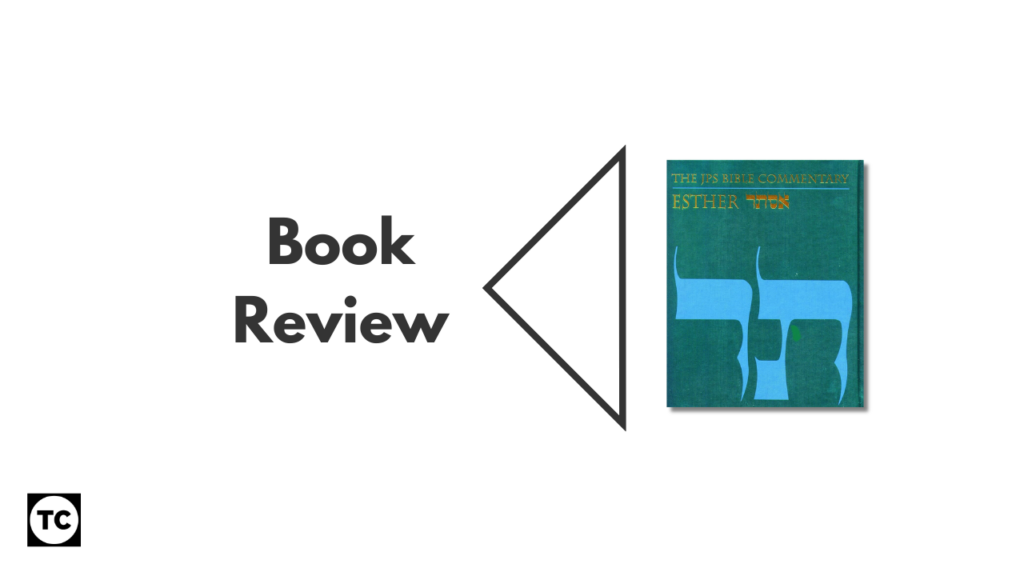Reviewing commentaries is a tricky business – particularly for me as a generalist, and an in-publisher editor of commentaries! I tend to offer my review based on the format and content of the volume, and its utility or otherwise to preachers and pastors. Occasionally I’ll digress into particularly theological or stylistic quirks.

I begin this review with a confession – this is the first time I’ve read through one of these Jewish Publication Society Bible Commentary volumes (JPS) cover to cover. I’ve previously dipped in for reference, but the experience of reading one of these straight through is a delight. If you’ve not come across the JPS series before, these are a Jewish commentary on the books of what Christians call the Old Testament, and true to their Hebrew roots, the pages run right to left, rather than left to right, echoing how Hebrew is read. The physical volumes are somewhere between a regular rectangle and a square – the hardbacks are beautifully produced, and the requirement to read right to left forces a Christian reader like me to read more carefully, and remind us of the reality of the Hebrew text, and that there is a Jewish community who value this text too.
After 59 pages of front matter (preface, introduction, notes to introduction), the commentary proper seems relatively brief, at 92 pages – but these are larger-pages-than-normal (if normal is a regular sized Christian commentary), with the width and height providing more space. The commentary uses endnotes rather than footnotes – which makes for a more reader-friendly experience, contrasted with a slightly irritating experience for some readers looking for references!
Berlin’s introduction covers a number of things – mostly relatively straightforward, but with an interesting note about feminist commentary: she doesn’t do that in this volume, but it is on her radar. The particular kind of text that Esther is, is well served by Berlin – a wonderful mix of a variety of things, including comedy and burlesque (in the technical sense), and as she notes “The book opens and closes with a series of banquets. At the beginning, Ahasuerus gives a banquet for the nobility from throughout the empire and then for the residents of Susa. This has its counterpart in the feasting of Purim at the end of the book, which is celebrated by the Jews throughout the empire on 14 Adar and by the Jews of Shushan on 15 Adar.” (p. xxv). This is a carefully crafted work, the book of Esther, and Berlin is a really careful reader and expositor of the text as a whole. In fact, as a non-Hebrew-specialist, my one critical comment about the book would be that whilst it does deal with textual formation issues (i.e. how Esther came to be), it doesn’t particularly engage with textual details, in the way that some commentaries do. This means that in my reading, this is a helpful commentary for evangelical preachers and pastors to engage with, for a fresh angle on a text that may seem familiar.
As a Jewish commentary, this volume obviously doesn’t have the same biblical-theological/christological approach of an explicitly Christian commentary, but that is not a reason to dismiss it. The canonical connections with other parts of the Old Testament are a vital part of Berlin’s work here, whether it be around the inauguration of Purim: “Esther is, as it were, imitating the Torah by authorizing the holiday of Purim” (p. xxxvii – the subsequent section of the introduction is helpful for more specific links to books/bodies of books), or to comparisons with particular key characters in the Old Testament narratives, such as Job, and others: “There are echoes of Joseph and Daniel, who also served at foreign courts and rose quickly in the esteem of others (Gen. 39:4, 21; Dan. 1:9). While it is usually Mordecai who is compared to Joseph and Daniel, Esther, too, shares in the theme of the successful courtier. She does so, however, in distinctly feminine terms: it is her beauty that leads to her success” (p. 26). One theme that became particularly apparent to this reader was that of expansion, with seemingly small-scale things becoming much bigger issues. The classic case in point is of course Mordecai’s perceived slight of Haman, noted in 3:8 as ‘who do not obey the king’s laws‘, with Berlin commenting “On a superficial level, this could refer to the fact that Mordecai refused to obey the royal command to bow to Haman. But the accusation is couched in different, and broader, terms…” (p. 40). This interplay is of course embodied in the person of Esther, with her life and her people being the focus of the story in an unexpected way.
Overall, then, this is a beautifully produced, extremely readable, and surprisingly accessible commentary on the book of Esther. Written from a Jewish perspective, both the format and content confront the Christian reader with the reality of this Old Testament story, both in terms of it’s meaning, and interpretation through the centuries. Whilst it won’t be for everyone, it is well worth the time, and I’d be sure to return to it, possibly to read through again, were I preaching Esther. Whilst I understand the decision, publishing-wise, to print right to left rather than left to right, I do wonder if it does make this hard to access, and I felt that endnotes were the wrong choice. So it isn’t my first choice on Esther – but it probably is an essential one.
4/5
Leave a Reply